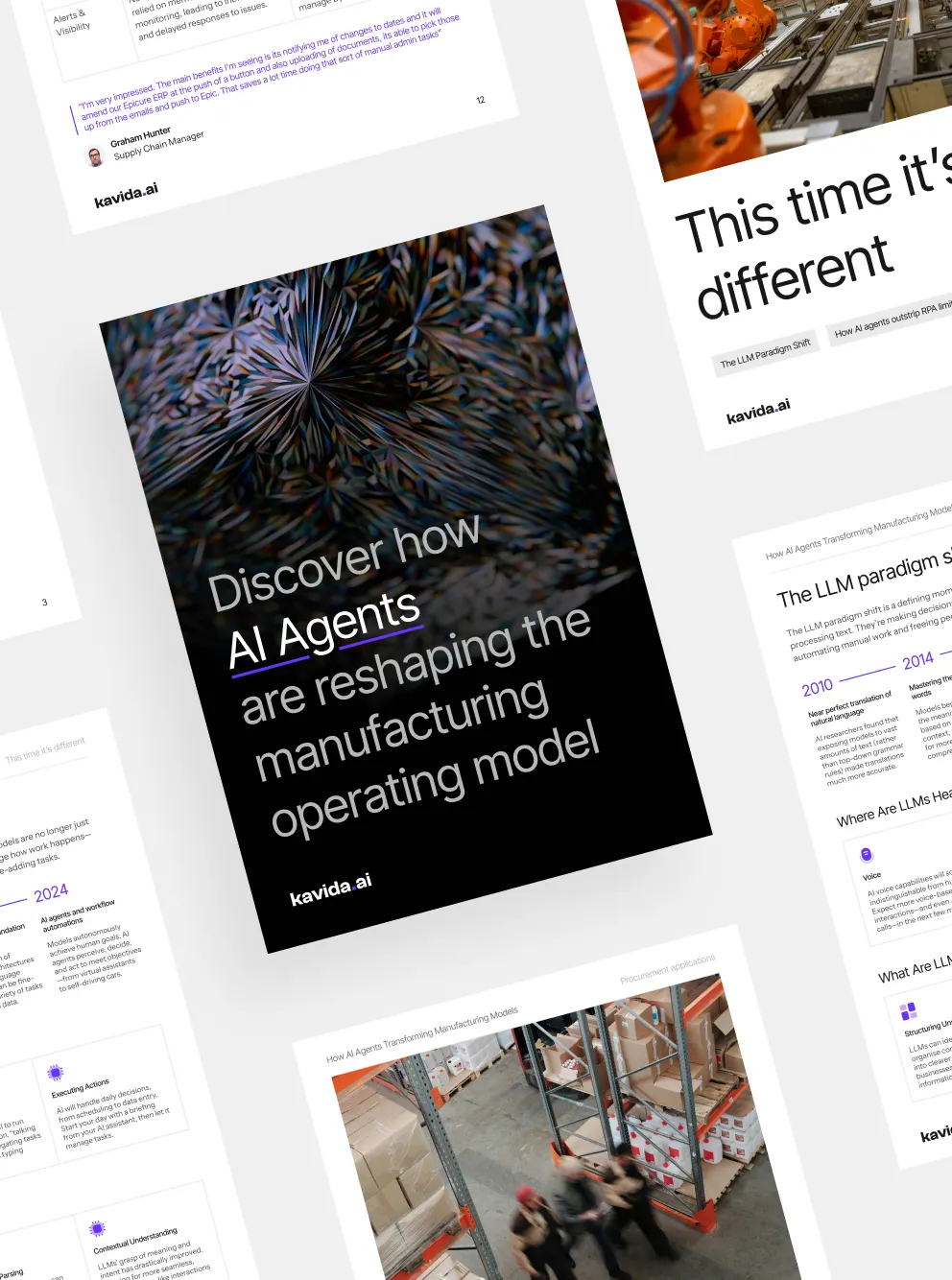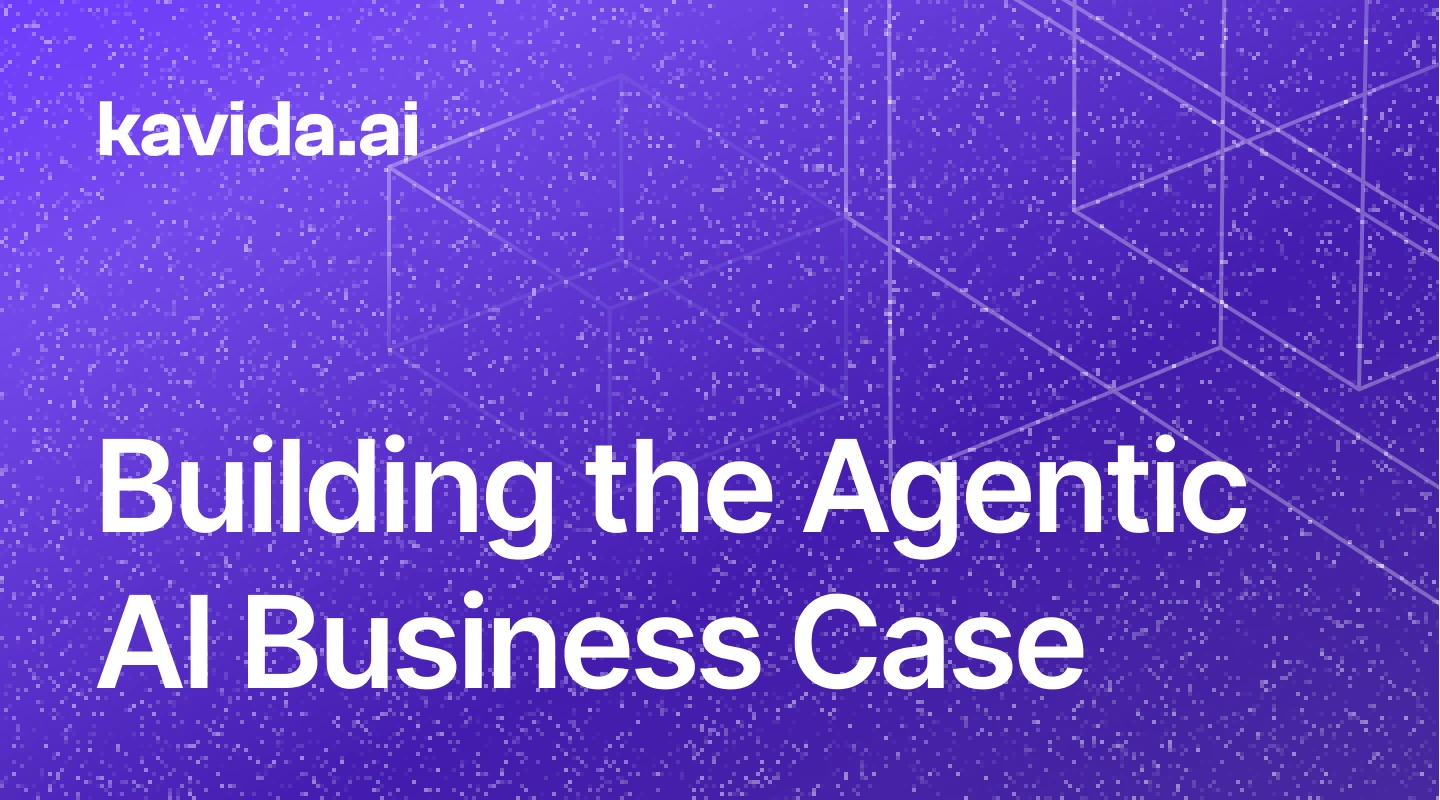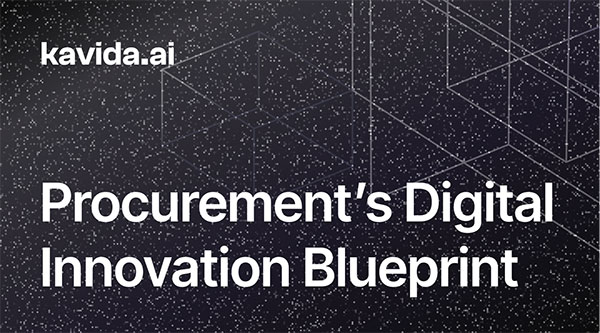

Discover how AI agents are reshaping the manufacturing operating model

Hi, I’m Alison!
Share your details, and I’ll give you a call in minutes to see how we can assist.

The Ultimate Guide to Procuring Generative AI for Your Manufacturing Company
Table of Contents
ToggleIn today’s fast-paced business world, procurement and supply chain teams need to make decisions quickly and accurately. But for many organizations, the data needed for these decisions is spread across many software systems—from ERP and SCM to procurement and logistics tools. This leads to fragmented information, data silos, and manual processes that slow down decision-making and reduce efficiency. That’s where Agent PO comes in: an AI-powered solution that brings all the data together, automated workflows, and helps teams make faster, smarter decisions.
Why Clean ERP Data Matters for Manufacturers
Essential Systems Used by Procurement and Supply Chain Teams
System Type | Description | Examples |
Enterprise Resource Planning (ERP) | Integrates various functions like procurement, finance, inventory, and production planning to provide data consistency and collaboration across departments. | SAP, Oracle, Microsoft Dynamics 365, Infor |
Procurement Management | Manages sourcing, supplier management, contracts, purchase orders, and spend analysis to streamline procurement processes and improve supplier collaboration. | Coupa, Ariba, Jaggaer, GEP Smart |
Supply Chain Management (SCM) | Optimizes the flow of goods and materials throughout the supply chain, including demand forecasting and inventory optimization. | SAP SCM, Oracle SCM, Blue Yonder, Kinaxis |
Inventory Management | Monitors stock levels, replenishes inventory, and tracks inventory movement to optimize stock levels and reduce carrying costs. | Zoho Inventory, Fishbowl, Cin7 |
Spend Analysis | Analyzes procurement spending by supplier, category, or region to identify cost-saving opportunities and improve efficiency. | Coupa Spend Analysis, SAP Ariba Spend Analysis, Rosslyn Spend Analytics |
Logistics and Transportation (TMS) | Manages logistics operations such as route planning, carrier selection, and shipment tracking to ensure on-time deliveries and control transportation costs. | Oracle TMS, SAP TMS, MercuryGate |
Demand Planning and Forecasting | Predicts customer demand based on historical sales and market trends to align inventory and purchasing strategies effectively. | SAP IBP, Oracle Demantra, Kinaxis RapidResponse |
Document Management | Stores and organizes procurement documents, ensuring compliance and easy access to contracts, purchase orders, and certifications. | DocuWare, OpenText |
Collaboration and Communication | Enables cross-functional communication and task coordination to ensure alignment between procurement, logistics, and finance teams. | Microsoft Teams, Slack, Asana |
Challenges of Making Strategic Decisions with Disparate Systems
When data is spread across multiple systems, procurement and supply chain teams face several limitations and challenges in making strategic decisions:
- Data Silos
- Challenge: Different systems may hold crucial information in isolation, preventing teams from accessing a holistic view of the entire supply chain.
- Impact: Lack of data integration makes it difficult to understand end-to-end supply chain performance, leading to missed opportunities and incomplete analysis.
- Challenge: Different systems may hold crucial information in isolation, preventing teams from accessing a holistic view of the entire supply chain.
- Data Inconsistency
- Challenge: Data recorded across multiple systems may be inconsistent, with discrepancies in data formats, metrics, or versioning.
- Impact: Inconsistent data can lead to inaccuracies in decision-making, misaligned processes, and unreliable reporting, reducing trust in the data used for strategy.
- Challenge: Data recorded across multiple systems may be inconsistent, with discrepancies in data formats, metrics, or versioning.
- Limited Real-Time Visibility
- Challenge: Some systems may not support real-time data updates or may operate in batch mode, leading to delays in data synchronization.
- Impact: Without real-time visibility, teams may miss out on critical, time-sensitive decisions, such as mitigating supplier disruptions or adjusting inventory levels promptly.
- Challenge: Some systems may not support real-time data updates or may operate in batch mode, leading to delays in data synchronization.
- Complexity in Data Integration
- Challenge: Integrating data from multiple systems (e.g., ERP, SCM, TMS) can be complex due to compatibility issues, lack of APIs, or differing data structures.
- Impact: The complexity of integration increases IT overhead and costs, making it challenging to unify and make sense of data without significant manual effort.
- Challenge: Integrating data from multiple systems (e.g., ERP, SCM, TMS) can be complex due to compatibility issues, lack of APIs, or differing data structures.
- Manual Data Handling
- Challenge: Without seamless integration, teams may rely on manual data collection, transformation, and analysis.
- Impact: Manual processes are time-consuming, error-prone, and limit the ability to gain timely insights, ultimately slowing down decision-making.
- Challenge: Without seamless integration, teams may rely on manual data collection, transformation, and analysis.
- Inefficient Collaboration
- Challenge: Different teams may use different systems for their respective functions (e.g., finance using ERP, procurement using sourcing platforms), making collaboration cumbersome.
- Impact: Lack of unified data makes it difficult to align cross-functional teams on strategic decisions, leading to inefficient workflows and miscommunication.
- Challenge: Different teams may use different systems for their respective functions (e.g., finance using ERP, procurement using sourcing platforms), making collaboration cumbersome.
- Inability to Scale Insights
- Challenge: Different systems may not be able to support a growing volume of data or provide advanced analytics capabilities.
- Impact: As procurement and supply chain operations scale, teams may struggle to generate insights from data scattered across disparate systems, limiting the ability to leverage predictive and prescriptive analytics.
- Challenge: Different systems may not be able to support a growing volume of data or provide advanced analytics capabilities.
How Agent PO Integrates with multiple systems enabling faster strategic decisions
1. Spend Visibility
- Description: This use case helps users gain comprehensive visibility into procurement spend, allowing them to track and categorize expenses effectively.
- How It Works: Agent PO collates and analyzes procurement transactions to provide clear insights into spending.
- Example Questions:
- “What is the total spend on category X this year?”
- “Can you provide a summary of indirect procurement costs?”
- “Which departments have the highest procurement costs?”
2. Supplier Spend Report
- Description: This use case allows users to gain insights into the organization’s spending patterns with different suppliers. It helps identify opportunities for cost optimization by consolidating or renegotiating contracts.
- How It Works: By analyzing procurement data, Agent PO identifies the total spend per supplier, trends over time, and areas with potential for cost reduction.
- Example Questions:
- “What is our spend with Supplier X over the last six months?”
- “Can you give me a breakdown of spend across all suppliers for this year?”
- “Which suppliers account for the highest procurement costs?”
3. Supplier Scorecard
- Description: The Supplier Scorecard feature helps evaluate supplier performance based on various metrics such as on-time delivery, quality, and price. It supports strategic supplier management by providing a clear performance assessment.
- How It Works: Agent PO aggregates data from procurement, quality control, and logistics to create a scorecard for each supplier.
- Example Questions:
- “How did Supplier Y perform over the last quarter?”
- “Which suppliers had the best on-time delivery rates this year?”
- “What is the scorecard summary for our top 5 suppliers?”
4. Supplier Risk Alert
- Description: This use case alerts users to potential risks involving their suppliers, such as financial instability, quality issues, or capacity problems that may affect supply chain continuity.
- How It Works: Agent PO continuously monitors supplier data and market intelligence to detect red flags and sends alerts.
- Example Questions:
- “Are there any risks associated with Supplier Z at the moment?”
- “Can you show me suppliers flagged for potential disruptions?”
- “What are the recent alerts regarding supplier risk?”
5. Increasing Working Capital
- Description: This feature helps identify opportunities to optimize working capital by improving procurement terms, optimizing inventory, and improving cash flow.
- How It Works: Agent PO provides recommendations to reduce excess inventory, renegotiate payment terms, or minimize procurement cycles.
- Example Questions:
- “How can we increase our working capital this quarter?”
- “Which inventory items are tying up the most capital?”
- “Can you suggest suppliers where we could negotiate better payment terms?”
6. Reducing Sourcing Costs
- Description: This use case identifies opportunities for reducing sourcing costs, either through negotiation, strategic sourcing, or by finding alternative suppliers.
- How It Works: Agent PO analyzes historical purchasing data and market pricing to recommend actions that reduce procurement costs.
- Example Questions:
- “How can we reduce sourcing costs for raw material X?”
- “Which suppliers offer the lowest cost for a similar quality of products?”
- “What are the opportunities for cost savings in sourcing this year?”
7. Reducing Risks
- Description: This feature helps users proactively manage risks across the supply chain, identifying possible vulnerabilities and providing mitigation recommendations.
- How It Works: Agent PO reviews data related to suppliers, logistics, and inventory to identify potential risks and create action plans.
- Example Questions:
- “What are the biggest risks in our supply chain?”
- “Which suppliers are likely to cause disruptions?”
- “Can you provide recommendations for mitigating procurement risks?”
8. Reducing Stagnant Inventory
- Description: Helps identify inventory that is stagnant or slow-moving, so users can take action to avoid carrying costs or write-offs.
- How It Works: Agent PO monitors inventory levels and identifies items that are not moving quickly, along with recommendations for reducing excess.
- Example Questions:
- “Which inventory items have been stagnant for more than 90 days?”
- “How can we reduce excess inventory for product Y?”
- “What is the current value of our slow-moving inventory?”
9. Reducing Forecast Errors
- Description: This feature assists in improving demand forecast accuracy, which helps in better production planning and inventory management.
- How It Works: Agent PO compares historical demand forecasts with actuals, identifies discrepancies, and suggests improvements.
- Example Questions:
- “What is our current forecast error rate for product X?”
- “How can we improve the accuracy of our demand forecast?”
- “Which products have the highest deviation between forecast and actual demand?”
10. Working Capital Reduction
- Description: This use case helps organizations manage their working capital by optimizing procurement, reducing excess inventory, and improving payment terms.
- How It Works: Agent PO provides a set of actionable recommendations to optimize procurement costs, manage inventory, and negotiate favorable terms.
- Example Questions:
- “What actions can we take to reduce our working capital requirements?”
- “Which suppliers should we renegotiate payment terms with to reduce cash outflow?”
- “How much working capital is tied up in inventory right now, and how can we reduce it?”
The Ultimate Guide to Procuring Generative AI for Your Manufacturing Company
Table of Contents
Toggle
Author:

Kevin Musprett
Head of Growth at Kavida.ai
Kevin drives GTM at Kavida, an AI agent used by manufacturing purchasing teams so they never miss a critical order from suppliers. Kevin dedicates himself to building and scaling kavida.ai to become the PO management platform of choice for an addressable market of over 15 million users.
Related articles

The Agentic Transformation in Manufacturing: From Specialised AI Assistants to Intelligent Systems
Procurement leaders today need more than just efficient workflows—they need insights that drive smart decision-making. For decision makers...

A Procurement Champion’s Guide to Building the AI Business Case
Procurement leaders today need more than just efficient workflows—they need insights that drive smart decision-making. For decision makers...

The Procurement Blueprint for Human-Centric Digital Innovation
Procurement leaders today need more than just efficient workflows—they need insights that drive smart decision-making. For decision makers...
